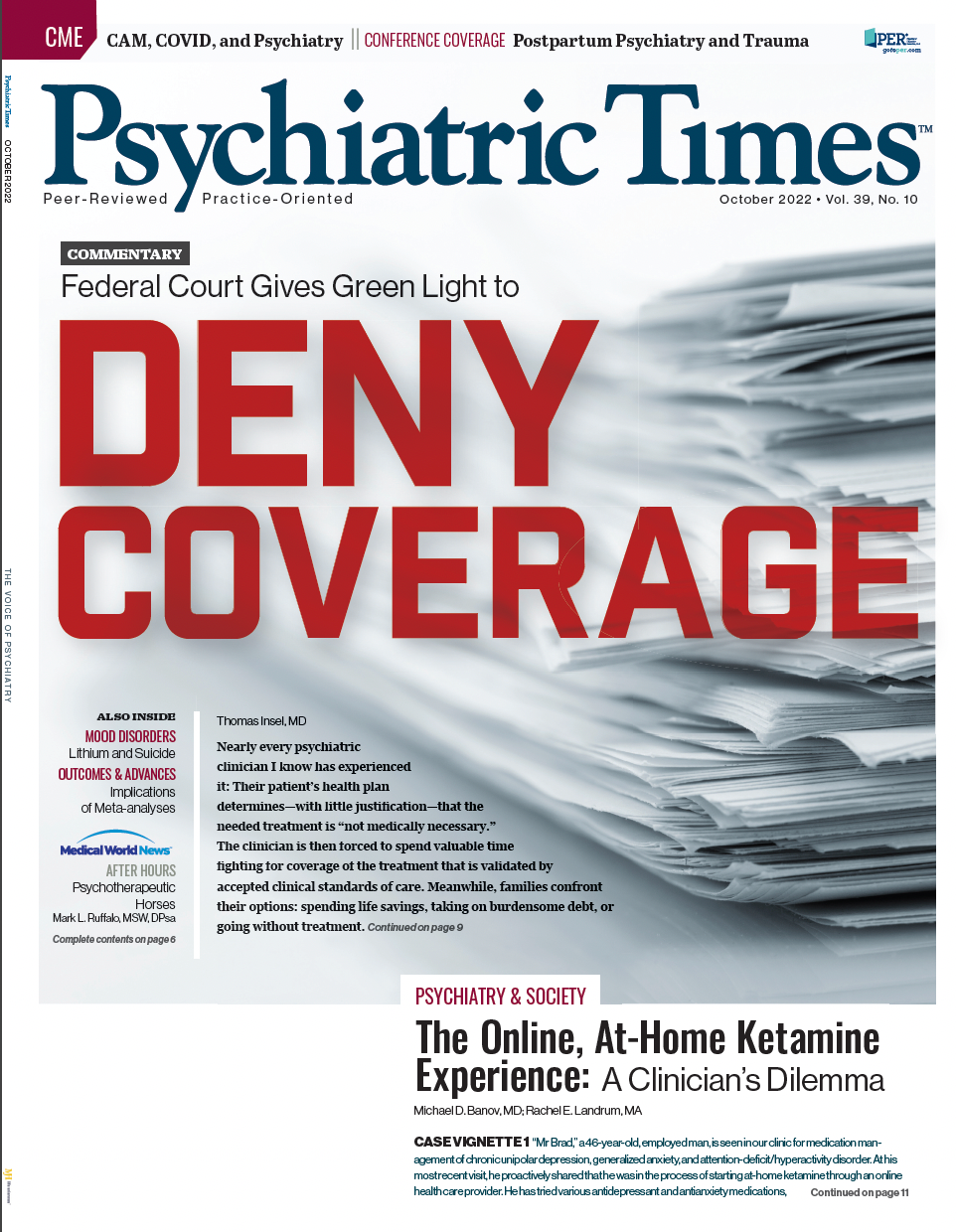Publication
Article
Psychiatric Times
Psychiatric Times™ Conference: Clinical Pearls, New Research
Author(s):
Did you miss the 2022 Annual Psychiatric Times™ World CME Conference? We've got you covered.

Leaders in psychiatry from across the country gathered in San Diego, California, for the 2022 Annual Psychiatric Times™ World CME Conference. For maximal flexibility for attendees, the conference was available via a live virtual platform as well as in person. As in previous years, the conference’s signature format of 20-minute interactive presentations allowed for coverage of a range of topics, including advances in the field, overcoming diagnostic challenges, and new and novel treatment strategies. In addition to the presentations, in-person attendees had the opportunity to discuss issues and ask questions in small groups, including a Meet the Editor Breakfast.
Managing Psychiatric Disorders During Pregnancy and Postpartum
“We always want to make sure we weigh the risks of the untreated psychiatric disorder when we are considering treatments, especially medication exposures, for women of reproductive age,” Marlene Freeman, MD, professor of psychiatry at Harvard Medical School, told attendees.
In her presentation “Pregnancy and Postpartum Management of Psychiatric Disorders,” Freeman discussed the importance of focusing on antidepressant treatment in women with depression during their reproductive years. Approximately 45% of pregnancies in developed countries are unplanned, Freeman shared, and 75% of teen pregnancies are unplanned.1 Furthermore, 82% of US women have had a child by aged 40 years.1 This is why it is important to tend to psychiatric disorders, which carry risks for both mother and baby if left untreated.
“The risks of the untreated psychiatric disorders impact efficacy and outcomes as well as child development overall,” Freeman said.
Freeman also explained the absolute risk of selective serotonin reuptake inhibitor (SSRI) exposure in pregnancy is small, and reproductive safety data on SSRIs exceed what is known about many other medications used in pregnancy. Prevalence of SSRI use during pregnancy is 3% to 7%, she added.2-7
Antidepressant Use and Risk. According to recent research, there is no evidence of increased risk for major malformations or cardiovascular malformations in the offspring of women who took SSRIs while pregnant.8
Another concern heard about SSRIs is the potential increased risk of autism. However, Freeman shared that studies and meta-analyses results indicating an association of SSRIs with increased risk of autism is not by cause and effect; maternal psychiatric illness must be factored in, she said, and that appears to be the driving factor.9
Treatment Recommendations for Postpartum Depression. “Postpartum depression has been called the most common obstetrical complication,” Freeman told attendees. Approximately 10% to 15% of women experience major depressive episodes post-delivery, and that number increases to 25% to 40% if the woman has a history of major depressive disorder, she explained.
Freeman had a number of tips for treating mothers with postpartum depression, including using the lowest effective doses of SSRIs, consulting with perinatal/reproductive psychiatry specialists as needed, and maximizing nonmedication treatments. Nonpharmacologic strategies include maximized social supports, psychoeducation of patient and family, group therapy or support groups, interpersonal therapy, and cognitive behavioral therapy.10-12
The Massachusetts General Hospital Center for Women’s Health hosts additional resources for clinicians and their patients on its website (www.womensmentalhealth.org), Freeman added.
“There are a lot of unknowns involved with pregnancy,” Freeman concluded. “We want to make sure that the treatment decisions we make are really collaborative with patients.”
References
1. Louik C, Lin AE, Werler MM, et al. First-trimester use of selective serotonin-reuptake inhibitors and the risk of birth defects. N Engl J Med. 2007;356(26):2675-2683.
2. Einarson TR, Einarson A. Newer antidepressants in pregnancy and rates of major malformations: a meta-analysis of prospective comparative studies. Pharmacoepidemiol Drug Saf. 2005;14(12):823-827.
3. Einarson A, Pistelli A, DeSantis M, et al. Evaluation of the risk of congenital cardiovascular defects associated with use of paroxetine during pregnancy. Am J Psychiatry. 2008;165(6):749-752.
4. Alwan S, Reefhuis J, Rasmussen SA, et al. Use of selective serotonin-reuptake inhibitors in pregnancy and the risk of birth defects. N Engl J Med. 2007;356(26):2684-2692.
5. Greene MF. Teratogenicity of SSRIs--serious concern or much ado about little? N Engl J Med. 2007;356(26):2732-2733.
6. Hallberg P, Sjoblom V. The use of selective serotonin reuptake inhibitors during pregnancy and breast-feeding: a review and clinical aspects. J Clin Psychopharmacol. 2005;25(1):59-73.
7. Wogelius P, Nørgaard M, Gislum M, et al. Maternal use of selective serotonin reuptake inhibitors and risk of congenital malformations. Epidemiology. 2006;17(6):701-714.
8. Huybrechts KF, Palmsten K, Avorn J, et al. Antidepressant use in pregnancy and the risk of cardiac defects. N Engl J Med. 2014;370(25):2397-2407.
9. Andrade C. Antidepressant exposure during pregnancy and risk of autism in the offspring, 1: meta-review of meta-analyses. J Clin Psychiatry. 2017;78(8):e1047-e1051.
10. Cohen LS, Wang B, Nonacs R, et al. Treatment of mood disorders during pregnancy and postpartum. Psychiatr Clin North Am. 2010;33(2):273-293.
11. Pearlstein T, Howard M, Salisbury A, Zlotnick C. Postpartum depression. Am J Obstet Gynecol. 2009;200(4):357-364.
12. Branquinho M, de la Fe Rodriguez-Muñoz M, Maia BR, et al. Effectiveness of psychological interventions in the treatment of perinatal depression: a systematic review of systematic reviews and meta-analyses. J Affect Disord. 2021;291:294-306.
Childhood Trauma: 10 Tips for Screening and More
In his presentation “How to Assess/Diagnose Childhood Trauma,” Mark B. Hamner, MD, pointed out that Department of Health and Human Services data on child abuse underestimate traumatic exposure because they addressed only abuse and not other traumas. “And abuse is often not reported,” he added.
Children can experience a number of traumatic experiences beyond physical, sexual, or psychological abuse and neglect, said Hamner, including natural disasters or terrorism; family or community violence; the sudden or violent loss of a loved one; substance use disorder either personally or within their family; refugee and war experiences, including torture; serious accidents or life-threatening illness; and military family–related stressors, like deployment or parental loss. All can play a part in the child’s traumatic history.
Additionally, in the National Comorbidity Survey Replication Adolescent Supplement, which looked at a national survey of adolescents aged 13 to 17 years, the lifetime prevalence of DSM-IV posttraumatic stress disorder (PTSD) was 4.7% higher in girls.
Children and adolescents who identify as part of the LGBTQ+ community experience trauma at unique, higher rates. Common traumas include bullying, harassment, traumatic loss, intimate partner violence, physical and sexual abuse, stigma, and more.
“Somatization is a significant posttraumatic stress symptom,” added Hamner. “Some have argued this should be included in diagnostic criteria.”
An exemplifying study looked at the relationship between PTSD symptoms and somatization and between intelligence and somatization in child sexual abuse victims to determine whether the type of abuse had an effect on the relationship between PTSD symptoms and somatization.1
The study concluded that somatization in children who were sexually abused was influenced by the severity of PTSD symptoms and intelligence and the effect of the PTSD symptoms on somatization was moderated by type of abuse.
When screening children and adolescents for trauma, Hamner shared a few tips that might help:
1. Make time in therapy sessions to complete screening measures with family members.
2. Allow the parent and child to choose the language in which the screen is completed.
3. Use developmentally appropriate strategies, like a chalk or dry erase board.
4. Let them decide the order in which they complete measures when possible.
5. Use visual aids.
6. If the child is resistant, read aloud to them.
7. Offer to complete over 1 to 3 sessions.
8. Praise all children and parents for “hard work.”
9. Check endorsement of critical items like hurting oneself and develop a safety plan.
10. Take time to explain what will happen next and clarify that you will readminister measures on an ongoing basis.
The National Child Traumatic Stress Network is an important resource, Hamner also noted. Specifically, he mentioned the Child and Adolescent Trauma Screen (CATS) instrument, as it is downloadable and brief, taking only 5 to 10 minutes to complete.2 This could be a helpful tool in the screening arsenal, he said.
“There are unique developmental considerations in this age range,” Hamner concluded. “It’s a vastly under-researched area, not only in terms of epidemiology but also in terms of treatments.”
References
1. Bae SM, Kang JM, Chang HY, et al. PTSD correlates with somatization in sexually abused children: type of abuse moderates the effect of PTSD on somatization. PLoS One. 2018;13(6):e0199138.
2. Child and adolescent trauma screen. International Society for Traumatic Stress Studies. Accessed August 12, 2022. https://istss.org/clinical-resources/child-trauma-assessments/child-and-adolescent-trauma-screen-(cats)
Trauma in the DNA: Educator of the Year Lecture
“Real true, posttraumatic stress disorder [PTSD] is going to have an impact, certainly on the next generation and maybe generations after that,” said Rachel Yehuda, PhD. Yehuda, who was named Educator of the Year, shared her research on the potential genetic passing of PTSD through generations.
Previous research by Yehuda et al showed adult offspring of Holocaust survivors had differential effects of maternal and paternal PTSD in both glucocorticoid receptor sensitivity and vulnerability to psychiatric disorder. With both maternal and paternal PTSD, offspring had lower GR-1F promoter methylation; with just paternal PTSD, offspring had GR-1F promoter hypermethylation.1 Furthermore, Holocaust exposure induced intergenerational effects on FKBP5 methylation; specifically, Holocaust survivors and their adult children showed a non-genotype-dependent change in methylation compared with their respective controls.2 This was the first demonstration of an association of preconception parental trauma with epigenetic alterations that is evident in both exposed parent and offspring.
Similar findings resulted from Yehuda’s work on the effects of 9/11. For example, in a post-9/11 program surveilling women who were pregnant, Yehuda et al collected salivary cortisol from mothers and babies.3 “What we found is that the mothers who felt PTSD, their cortisol levels were lower, but it’s also lower in babies, which was really wild,” said Yehuda. “But here’s the kicker: Both cortisol levels are lowest in the babies of mothers with PTSD who were exposed in the third trimester.”
This research suggests maternal PTSD may confer additional in utero effects, causing more anxiety.3 Trauma exposure during pregnancy directly affects the fetus and fetus germ cells, Yehuda shared.3
Yehuda explained that epigenetic changes could survive cell division associated with the formation of sperm and eggs; if the parent is exposed to trauma, their exposure could result in epigenetic changes that may affect their sperm or egg—meaning a single trauma could simultaneously affect multiple generations without direct exposure.
“This is inherited in our DNA,” said Yehuda. “Trauma is inherited.”
The biological remnants of parental experiences in our DNA can affect us in multiple ways, according to Yehuda. They can influence our response to stressors/challenges, make us better able to detect and respond to threats, increase vulnerability to mental health disorders, and increase our attunement to injustice. They are enduring, but not irreversible, Yehuda stressed.
References
1. Yehuda R, Daskalakis NP, Lehrner A, et al. Influences of maternal and paternal PTSD on epigenetic regulation of the glucocorticoid receptor gene in Holocaust survivor offspring. Am J Psychiatry. 2014;171(8):872-880.
2. Yehuda R, Daskalakis NP, Bierer LM, et al. Holocaust exposure induced intergenerational effects on FKBP5 methylation. Biol Psychiatry. 2016;80(5):372-380.
3. Yehuda R, Engel SM, Brand SR, et al. Transgenerational effects of posttraumatic stress disorder in babies of mothers exposed to the World Trade Center attacks during pregnancy. J Clin Endocrinol Metab. 2005;90(7):4115-4118.
Read More: psychiatrictimes.com/conferences/world-cme-conference






